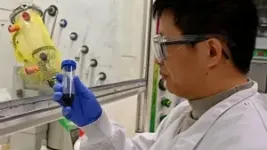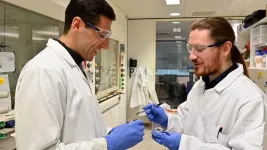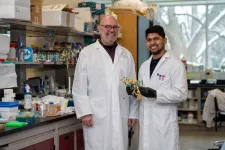(Press-News.org) CLEVELAND—The body’s cells respond to stress—toxins, mutations, starvation or other assaults—by pausing normal functions to focus on conserving energy, repairing damaged components and boosting defenses.
If the stress is manageable, cells resume normal activity; if not, they self-destruct.
Scientists have believed for decades this response happens as a linear chain of events: sensors in the cell “sound an alarm” and modify a key protein, which then changes a second protein that slows or shuts down the cell’s normal function.
But in a new study published today in the journal Nature, researchers at Case Western Reserve University have discovered a cell’s response is more nuanced and compartmentalized—not fixed or rigid, as previously thought.
The groundbreaking research suggests this adaptive response to stress— which the researchers call “split-integrated stress response” or s-ISR—could potentially be exploited to kill cancer cells and more effectively treat neurodegenerative diseases.
Maria Hatzoglou, professor of the Department of Genetics and Genome Sciences at the Case Western Reserve School of Medicine and the study’s principal investigator, found for the first time a cell’s response to stress can be fine-tuned depending its nature, intensity and duration. This flexibility provides novel insights into how cells in organisms—from yeast to humans—adapt to their environment.
“This study represents a new way of thinking about cellular stress,” Hatzoglou said. “ISR is not a one-size-fits-all system like we used to think. Instead, it can change and adjust depending on the type, strength and length of the stress the cell is experiencing.”
The study
The study used mouse models of Vanishing White Matter Disease, which causes progressive degeneration of the brain’s white matter in children, leading to neurological problems like motor difficulties, seizures and cognitive decline.
Hatzoglou’s research revealed that cells carrying the gene causing the disease had mutations in the key protein normally responsible for shutting down operations in the cell under stress. Somehow, the brain cells adapt and mostly function normally but are exceptionally vulnerable, self-destructing even under mild stress.
The research team, which included colleagues at Case Western Reserve, McGill University and Karolinska Institute, determined how the cells reacted explains why patients show significant decline in cognitive and motor abilities after relatively minor stressors like fever or mild head trauma.
Other late-onset neurodegenerative diseases like multiple sclerosis and amyotrophic lateral sclerosis (better known as ALS) may share a similar mechanism, the researchers said. Diseased brain cells adapt to preserve functions under normal conditions, but modest stressors accelerate decline.
Understanding this adaptation to stress could lead to new targets for cancer chemotherapy, Hatzoglou said, because cancer cells respond to stressors like chemotherapy in one of two ways: either self-destruct or mutate to preserve their function, becoming resistant to the treatment.
With that knowledge, she said she plans to study chemotherapy-resistant breast cancer cells to better understand how those cells adapt to stress and find new targets for treating disease.
The study was funded by the National Institutes of Health, Case Comprehensive Cancer Center, Terry Fox Foundation Oncometabolism Team, Canadian Institutes for Health Research, Swedish Research Council, Swedish Cancer Society and National Multiple Sclerosis Society.
###
At Case Western Reserve, one of the nation's leading research universities, we're driven to seek knowledge and find solutions to some of the world's most pressing problems. Nearly 6,200 undergraduate and 6,100 graduate students from across 96 countries study in our more than 250 degree programs across arts, dental medicine, engineering, law, management, medicine, nursing, science and social work. Our location in Cleveland, Ohio—a hub of cultural, business and healthcare activity—gives students unparalleled access to engaging academic, research, clinical, entrepreneurial and volunteer opportunities and prepares them to join our network of 125,000+ alumni making an impact worldwide. Visit case.edu to learn more.
END
How cells respond to stress is more nuanced than previously believed
Research discovery could lead to new targets for cancer therapy, neurodegenerative diseases
2025-03-26
ELSE PRESS RELEASES FROM THIS DATE:
A new method to recycle fluoride from long-lived PFAS chemicals
2025-03-26
UNDER EMBARGO UNTIL: 16:00 GMT / 12 NOON ET WEDNESDAY 26 MARCH 2025
A new method to recycle fluoride from long-lived PFAS chemicals
Images available via the link in the notes section.
Oxford Chemistry researchers have developed a method to destroy fluorine-containing PFAS (sometimes labelled ‘forever chemicals’) while recovering their fluorine content for future use. The results have been published today (26 March 2025) in Nature.
PFAS – which stands for poly- and perfluoroalkylated substances – have been produced in large ...
A breakthrough moment: McMaster researchers discover new class of antibiotics
2025-03-26
The last time a new class of antibiotics reached the market was nearly three decades ago — but that could soon change, thanks to a discovery by researchers at McMaster University.
A team led by renowned researcher Gerry Wright has identified a strong candidate to challenge even some of the most drug-resistant bacteria on the planet: a new molecule called lariocidin. The findings were published in the journal Nature on March 26, 2025.
The discovery of the all-new class of antibiotics responds to a critical need for new antimicrobial ...
The devastating human impact on biodiversity
2025-03-26
Humans are having a highly detrimental impact on biodiversity worldwide. Not only is the number of species declining, but the composition of species communities is also changing. These are the findings of a study by Eawag and the University of Zurich published in the scientific journal Nature. It is one of the largest studies ever conducted on this topic.
Biological diversity is under threat. More and more plant and animal species are disappearing worldwide, and humans are responsible. Until now, however, there has been no synthesis of the extent of human intervention in nature and whether the effects can be found everywhere in the world ...
Calorie-free sweeteners can disrupt the brain’s appetite signals
2025-03-26
Compared to sugar, consuming sucralose—a widely used sugar substitute—increases activity in the hypothalamus, a brain region that regulates appetite and body weight, according to a new USC study. Sucralose also changes how the hypothalamus communicates with other brain regions, including those involved in motivation. The study was just published in the journal Nature Metabolism.
About 40% of Americans regularly consume sugar substitutes, usually as a way to reduce calories or sugar intake. “But are these substances actually helpful for regulating ...
Researchers achieve quantum computing milestone, realizing certified randomness
2025-03-26
In a new paper in Nature, a team of researchers from JPMorganChase, Quantinuum, Argonne National Laboratory, Oak Ridge National Laboratory and The University of Texas at Austin describe a milestone in the field of quantum computing, with potential applications in cryptography, fairness and privacy.
Using a 56-qubit quantum computer, they have for the first time experimentally demonstrated certified randomness, a way of generating random numbers from a quantum computer and then using a classical supercomputer to prove they are truly random and freshly generated. This could pave the way towards the use of quantum computers for a practical task unattainable through ...
Lasso-shaped antibiotic co-developed by UIC evades standard drug resistance
2025-03-26
A small molecule shaped like a lasso may be a powerful tool in the fight against infectious diseases, according to a new study in Nature co-authored by University of Illinois Chicago researchers.
Lariocidin, a peptide made by bacteria living in soil, was effective against several different microbes responsible for deadly infections. UIC researchers working with collaborators at McMaster University in Canada determined how the new antibiotic works and why the drug evades bacterial resistance.
“The holy grail in the field is to find an antibiotic that binds to a new site target, has a novel mechanism of action and has ...
Two studies explore impact of pandemic on colorectal cancer screening and diagnosis
2025-03-26
INDIANAPOLIS – Two recent studies by researchers from Regenstrief Institute and the Indiana University School of Medicine explore the effect of the pandemic on colorectal cancer screening tests and diagnostic colonoscopies in Central Indiana. The findings of temporary disruption to the former and minimal impact on the latter are similar to findings across the U.S., contributing to the compendium of knowledge on preventive health uptake and subsequent treatment in various populations during the pandemic.
One study, published in PLoS One, examines both non-invasive and colonoscopy screening trends during the pandemic. The other study, ...
“Osteo-cardiovascular” patients at highest risk for falls and death, Chinese study finds
2025-03-26
A new study by researchers at Peking University and the Chinese PLA General Hospital has found that multimorbidity—living with multiple chronic diseases—is closely associated with worsening fall conditions and mortality among middle-aged and older adults in China. The findings, published in Health Data Science, identify a distinct group at especially high risk: individuals with both cardiovascular and musculoskeletal conditions, dubbed the “osteo-cardiovascular fallers.”
Falls are a major cause of injury and death in older populations globally, particularly ...
AI analysis of healthcare records reveals key factors in autism diagnosis
2025-03-26
Without clear and effective biological tests for autism based on genes, brain or blood measurements, diagnosis today still largely depends on clinical assessment. The standard way of doing this is by observing how the individual fits the criteria for autism listed in gold standard manuals like the Diagnostic and Statistical Manual of Mental Disorders, Fifth Edition (DSM-5).
These criteria are divided into two categories: one for restricted or repetitive behaviours, actions, or activities, and another for differences in social communication and interaction. In the end, however, it is the clinician, relying on years of ...
Repetitive behaviors and special interests are more indicative of an autism diagnosis than a lack of social skills
2025-03-26
People with autism are typically diagnosed by clinical observation and assessment. To deconstruct the clinical decision process, which is often subjective and difficult to describe, researchers used a large language model (LLM) to synthesize the behaviors and observations that are most indicative of an autism diagnosis. Their results, publishing in the Cell Press journal Cell, show that repetitive behaviors, special interests, and perception-based behaviors are most associated with an autism diagnosis. These findings have potential to improve diagnostic guidelines ...
LAST 30 PRESS RELEASES:
Missed signals: Virginia’s septic strategies overlook critical timing, study warns
Delayed toxicities after CAR T cell therapy for multiple myeloma are connected and potentially preventable
Scientists find cellular key to helping plants survive in saltwater
Medical cannabis program reduces opioid use
Immunotherapy works for sepsis thanks to smart patient selection
Cardiovascular events 1 year after RSV infection in adults
US medical prices and health insurance premiums, 1999-2024
Medical cannabis and opioid receipt among adults with chronic pain
Multichannel 3D-printed bioactive scaffold combined with siRNA delivery for spinal cord injury recovery
Triaptosis—an emerging paradigm in cancer therapeutics
A new paradigm in spectroscopic sensing: The revolutionary leap of SERS-optical waveguide integration and ai-enabled ultra-sensitive detection
Sweet tooth: How blood sugar migration in diabetes affects cavity development
Lowest suicide rate is in December but some in media still promote holiday-suicide myth
Record-breaking cosmic explosion challenges astronomers’ understanding of gamma-ray bursts
Excessive heat harms young children’s development, study suggests
Quanta Books to publish popular math and physics titles by Terence Tao and David Tong
Philanthropic partnerships fund next-generation instruments for mid-sized telescopes
AI offers ‘roadmap’ to plant genetics
Myosin XI-1: A key molecular target for salt-tolerant crops
Pusan National University study highlights the health hazards of ultrafine particles from small home appliances with electric heating coils and brushed DC motors
Global first: New Indigenous-led research initiative to revitalize legal orders
Transforming acoustic waves with a chip
When climate risk hits home, people listen: Study reveals key to engagement with disaster preparedness messaging
Major breakthrough against diabetes thanks to a microbial molecule that disarms inflammation
Silicon chips on the brain: Researchers announce a new generation of brain-computer interface
Getting rest is the best
Towards sustainable organic synthesis – Mechanochemistry replaces lithium with sodium in organic reactions
Wireless device ‘speaks’ to the brain with light
Greenhouse gases to intensify extreme flooding in the Central Himalayas
New study sheds light on Milky Way's mysterious chemical history
[Press-News.org] How cells respond to stress is more nuanced than previously believedResearch discovery could lead to new targets for cancer therapy, neurodegenerative diseases






